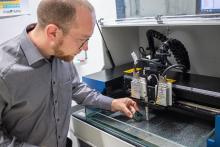The new cooperation laboratory for acoustics at the Centre for Efficient High Temperature Material Conversion (ZeHS) at TUBAF was opened in July 2024. The state-of-the-art laboratory serves as a central point of contact for acoustic measurements in the field of material and component characterisation and complements the existing analysis methods at the ZeHS.
"The new laboratory provides the ZeHS with one of two new cooperation laboratories for important methods of material analysis. The laboratory for ultrasound diagnostics, which is largely run by young researchers, has already actively contributed to the "Long Night of Science and Business" and inspired interested parties. In addition, the X-ray centre headed by Dr Hartmut Stöcker has found the right premises and will soon be set up," says Professor Dirk C. Meyer, scientific spokesperson for the ZeHS.
Under the direction of Professor Lutz Krüger and Junior Professor Christian Kupsch, the cooperation laboratory is an important resource for university members as well as external partners and research institutions. With a clear focus on acoustic measurement technology, the laboratory offers specialised expertise and state-of-the-art technology for investigating and analysing a wide range of materials and components. The laboratory's expertise includes guided waves, non-destructive testing, acoustic wave modelling, transducer design, signal processing and the application of artificial intelligence methods to analyse measurement data.
Please contact the responsible employee Dr Marcel Mandel at mandel [at] iwt [dot] tu-freiberg [dot] de (mandel[at]iwt[dot]tu-freiberg[dot]de) or the contact person at the ZeHS, Ass. iur. Theresa Lemser, at Theresa [dot] Lemser [at] zehs [dot] tu-freiberg [dot] de (Theresa[dot]Lemser[at]zehs[dot]tu-freiberg[dot]de).
Currently, the research work in the joint laboratory is focussed on the following topics:
- Guided waves (Prof. Krüger): Johannes Kirchgässner is currently working for the IWT on so-called Lamb wave propagation in plate-like structures for the remote damage diagnosis of large-area components. One focus of his work is on the triangulation of constructive interfering edge reflections for the localisation of damaged areas from a great distance. The partner Polytec GmbH provides a 3D vibrometer measuring system for this purpose, which visualises the wave field propagation and allows wave path tracing. The studies are used for the basic characterisation of the material condition that will later be subjected to high temperatures.
Mr Kirchgässner is a scholarship holder of the Interdisciplinary Scholarship Programme of the ZeHS, which started in the summer semester and was established with the support of the Stifterverband for the centre. The programme provides individual support for six scholarship holders per semester in the amount of €208 per month. In addition, the scholarship holders have access to funding for joint projects such as inviting guests, excursions, etc.
- Ultrasonic microscopy (Prof. Kupsch): Ultrasonic microscopy can be used to examine materials and components three-dimensionally with resolutions in the micrometre range. High-frequency ultrasound (50 MHz to 1.5 GHz) is used for this purpose. Ultrasound microscopy is used in particular to analyse semiconductors and microelectronic systems, but is also used to elucidate the structure of materials and material systems.
The new cooperation laboratory for acoustics at TU Freiberg thus offers an outstanding platform for innovative research and development and strengthens the university's position as a leading institution in materials science, particularly in the field of characterisation.
Infrastructure for interdisciplinary research
The Centre for Efficient High-Temperature Material Conversion (ZeHS) is home to over 40 working groups along the entire innovation chain at TU Bergakademie Freiberg. The collaboration aims to move from basic science, which was also founded in Freiberg, to industrial applications in line with the requirements of our time, such as environmental protection and energy efficiency. Evidence of this convinced the Science Council in 2015 to approve the research building for the ZeHS in Freiberg with funding from the federal government and the Free State of Saxony totalling 41.5 million euros.
The ZeHS is now a building that is open to the public on a weekly basis, and anyone who enters can see how lively and harmonious the building is. The building bears numerous visible Freiberg hallmarks in its architectural design and the users are also very happy to provide information about their scientific work. Various languages are spoken, including German, of course. There is also an exhibition of visual artists, which can be experienced in alternating periods. A great deal of thought has been given to cooperation and attention has been paid to the corresponding requirements. The lively cooperation now results in new syntheses. "It's great that we are working together in such a short space of time (the building was put into use in 2021 after construction was completed) to take our collaboration to the next level. Ideas, especially from young researchers, are being moderated and, above all, broadly supported," says Professor Dirk C. Meyer, who has been responsible for the overall project as scientific spokesperson since the application was submitted in 2013.
